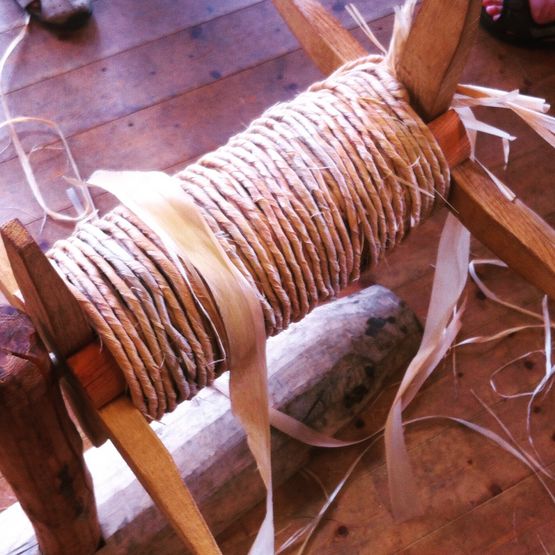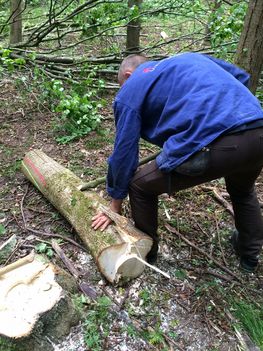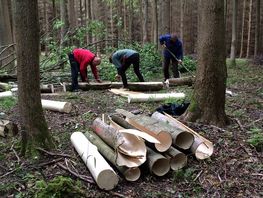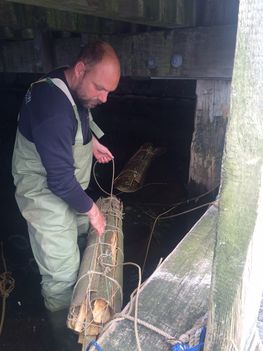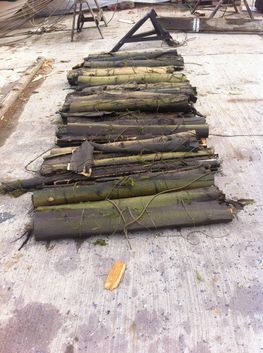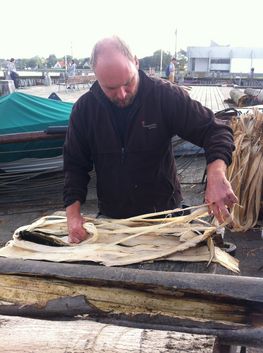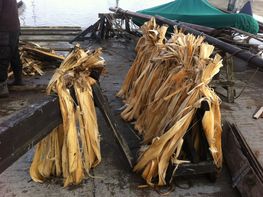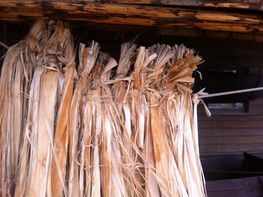Small-leaved lime (Tillia Cordata) was the most readily available material for ropemaking in the Viking Age. The lime (also known as linden) tree had a wide distribution and occupied roughly percentage of Danish forests as beech does today.
During June, the Lime bast for the Gislinge Boat’s rig was harvested in Gribskov in Northern Sjælland in co-operation with students from the Forestry School in Nødebo, and also in Vallø Stift forest, just outside of Køge. Selected trees were felled and the bark was then removed. The bark is harvested in June as turgor pressure in the tree’s cells during the early summer makes it easier to prise large pieces of bark off without excessive damage to the bast layer. As with so much else in boatbuilding, we prefer to use straight branches and knot-free trees. The trees shouldn’t be too old, as the bark begins to get rougher, stiffer and more difficult to work with. The trees are felled when they are between 30 to 40 years old.
After the bark was peeled off, it was laid in bundles weighing ca. 20kg and the bundles were tied together. 20 bundles were then laid for retting in a small, stagnant forest-lake in Boserup Forest, a short distance from Roskilde. Normally, the bast is retted in the water under the Museum quay. Simple and straightforward. However, from an experimental archaeological perspective, it’s important to gather more knowledge concerning how the process of decay occurs depending on the type of water used. The majority of plant materials tend to decay quicker in freshwater than in saltwater, so it was time to put the theory to the test.
On the 24th August, ropemaker Carsten and Silas were out in Boserup to raise the bundles from the water. It was dirty work: the bark was well on the way with the decaying process and smelled vile. It had also become soft and slimy and the bundles had a tendency to fall apart. The first thing that breaks down during the process of decay is pectin – the natural glue that holds the bast layers together.
Back in the Museum harbour, the task of separating the bast layers from the rough bark could begin. Once the pectin has begun to break down, it’s relatively easy to remove the bast from the bark. The bast is divided into strips ca. 8 – 10cm wide, rinsed in the harbour and hung to dry in bundles. Not all bast is of the same quality and the first grading of the material can take place at this stage. If the bast is stiff and rough or has too many small damaged areas, it’s discarded.
So far, we can conclude that retting in freshwater IS more effective than in saltwater. The pectin has mostly broken down and the bast layers are very easy to separate. Also, the strips of bast are not as friable when they dry out and the colour is more golden. We don’t know as yet what impact these qualities will have on the finished product in terms of tensile strength, flexibility and durability.
Carsten has now begun laying lime bast rope for the shrouds, fore-stay and braces, and once they’re finished and we start to use the boat actively, we can start gaining experience with, and drawing conclusions, in terms of how they perform. There is much we still don’t know about how Vikings used and made ropes. For many years, hemp rope has often been used for much of the rig, because we know how strong hemp is and it is a material we can trust. Unfortunately, hemp rope was not widely used during the Viking Age, and if we aim to reconstruct Viking Age ships and boats as they once were, it’s essential that we also use the same materials they did. The difference between hemp and lime bast is enormous. For example, hemp has a breaking load that is three times higher than bast. With hemp rope, you can easily tie a succession of knots, whereas lime bast does not respond well to being twisted, so if the rig was made of lime bast, it must have been made fast in another way.
How these problems can be solved is something that we’re only beginning to explore now, and bast is also just one of the many materials that the Vikings had available to them. The Gislinge Boat’s rig will also include ropes of horsehair, sealskin and wool: each material has its own strengths and weaknesses, but we can only find out what they are by using them.
When a large portion of the rig is ready and we’ve progressed further with the laying of the lime bast rope, we’ll bring an update on the progress.
» <link https: www.facebook.com external-link-new-window external link in new>Follow the project on Facebook...
» <link https: instagram.com vikingshipmuseum external-link-new-window external link in new>Follow the project on Instagram...
